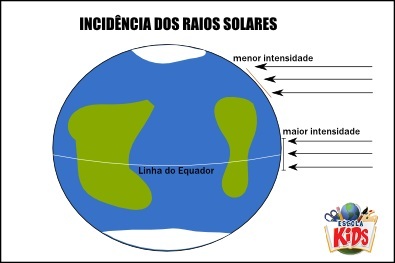THE Earth it has a geoid shape, that is, it is slightly flattened at the poles. Therefore, we say that it is almost spherical, that is, it presents itself as an almost perfect sphere. This feature means that it does not receive the sun's rays in the same way throughout its north-south extension.
See the diagram below:

Schematic illustrating the sun's rays on the Earth
Notice in the drawing above that the closer we are to the Equator Line (low latitudes), the greater the intensity of the sun's rays, as they fall perpendicularly on the ground in these areas. Likewise, the closer we are to the planet's poles, the lower the intensity of these rays.
This factor, added to the elements related to the solstices and equinoxes, results in the formation of different climatic bands over the Earth, which are larger in areas with latitudes close to 0º and smaller in polar areas, with latitudes close to 90º and -90º.
In the next diagram, we have the main climatic bands of the Earth, which are the glacial zones, the temperate zones and the intertropical zone.

Diagram illustrating the Earth's thermal zones
Arctic and Antarctic glacial zone: also called polar zones, the glacial zones have the lowest temperatures on the planet, as they are the ones that receive the sun's rays in less intensity. Thanks to the solstices, during part of the year, it is completely night in these areas, which contributes to lower temperature averages even further. Glacial zones cover all regions located north of the Arctic Circle and south of the Antarctic Circle.
north and south temperate zone: the temperate zones are where the four seasons of the year are more clearly perceived, which are revealed in a very well defined way. Because of the solstices, these zones are brighter for six months and less illuminated for the rest of the year, thus alternating between cold and heat. This climatic band covers the areas positioned between the tropics and the polar circles.
intertropical zone: also called equatorial zone, this climate range has the highest average temperature, with the greatest effect of heat and insolation. Because of this, the Amazon Forest region is very hot, with very high averages of temperature and evaporation.
By Me. Rodolfo Alves Pena


